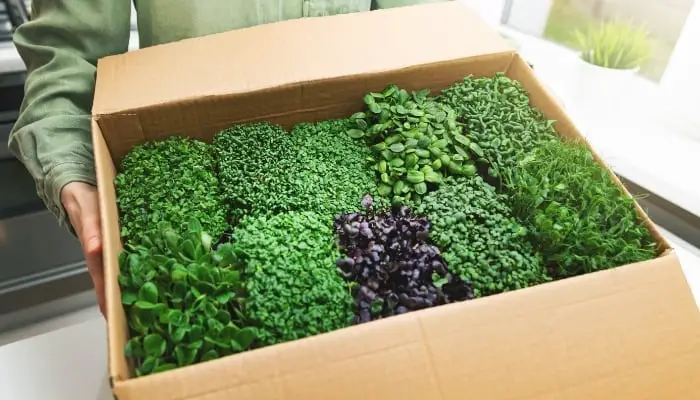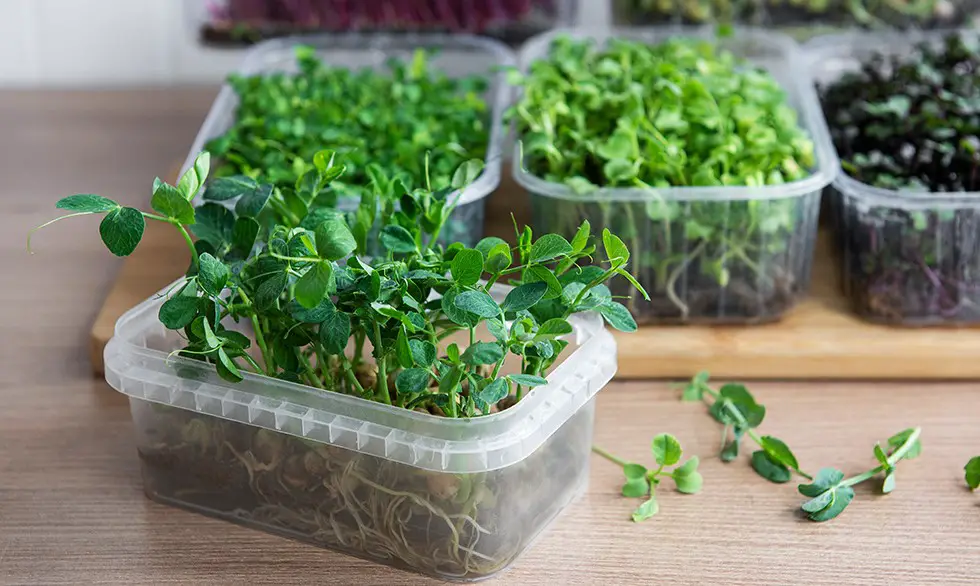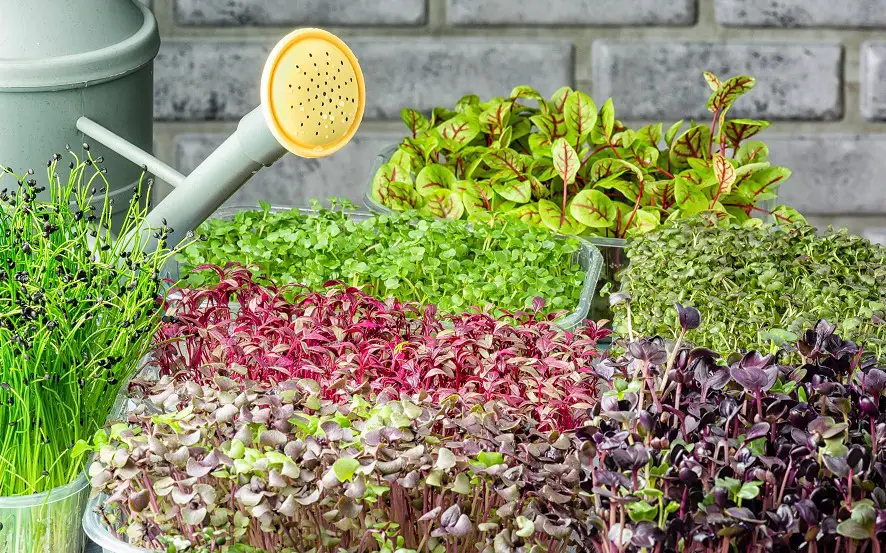To tap into a profitable market, consider selling micro greens to diners if you’re planning to begin or grow your microgreens business.
The popularity of microgreens has risen in recent times, attributed to their delicate flavor, vivid hues, and rich nutritional content, making them ideal healthy food for a range of dishes, such as salads, sandwiches, soups, and main courses.
In this article, you can find some recommendations to help you get started.

Contents
- 1 Research your local market
- 2 Offer a variety of microgreens
- 3 Get a business license
- 4 Grow your microgreens indoors
- 5 Offer microgreens samples
- 6 Build relationships with local restaurants and grocery stores
- 7 Create a fresh sheet
- 8 Deliver microgreens directly to restaurants
- 9 Consider offering organic microgreens and salad greens
- 10 Target small-scale growers
- 11 Provide cut microgreens to future clients
- 12 Tap into the catering market
- 13 FAQ
- 14 Conclusion
Research your local market
If you’re planning to sell microgreens to restaurants, it’s crucial to conduct thorough local market research beforehand. You’ll need to identify which varieties of microgreens are in high demand in your local area, as well as pinpoint the places that are most likely to purchase them from you.
To gather information about a local farmer’s market demand, consider attending local farmers’ markets and food events to get a sense of what’s currently popular in your community.
This will enable you to keep up-to-date with the latest trends and stay ahead of the competition in the microgreens business.
Additionally, conducting online research on restaurant menus and social media posts can provide you with valuable insights into what they are being used in different dishes and by which establishments.
By conducting research before venturing into the microgreens industry, you’ll be able to make informed decisions about your business strategy and tailor your product offerings to meet the needs of your target customers.
Offer a variety of microgreens
When it comes to pricing microgreens for farmers’ markets, it’s crucial to understand that different types of microgreens can have varying levels of demand. To appeal to various customers, offering a wide assortment can be beneficial.
From broccoli microgreens to corn shoots can be used in salads, sandwiches, and other dishes. By providing a range of flavors and textures, you can cater to different tastes and preferences, making your offerings more attractive to future consumers.
However, it’s important to keep in mind that some microgreens lose their quality and taste quickly, particularly if not stored properly. This can lead to a decrease in demand and lower pricing, which can negatively impact your profit margins. To prevent this, you may consider offering a salad mix and baby greens that have a longer shelf life.
One effective way to increase the visibility and sales of your microgreens is to offer them to local diners. By developing relationships with the restaurant chef and food service professionals in your area, you can sell microgreens to a steady lucrative market.

Get a business license
Before you start to sell microgreens, make sure you have all the necessary licenses and permits.
This will vary depending on where you live, so check with your local government to find out what you need. In most cases, you’ll need a business license, a food handler’s permit, and liability insurance.
It’s also a good idea to consult with a lawyer or accountant to ensure that you have all your legal and financial bases covered.
Grow your microgreens indoors
Growing microgreens is a delicate process that requires attention to detail and specialized knowledge. When growing microgreens indoors, it’s important to choose the right growing medium, such as soil or a hydroponic solution. You’ll also need to monitor the temperature, humidity, and lighting to ensure optimal growing conditions.
In addition, different types of microgreens have different growing requirements.
For example, some prefer cooler temperatures while others thrive in warmer conditions. It’s important to understand these differences and adjust your growing methods accordingly.
By mastering the art of growing microgreens indoors, you can offer your customers a consistent supply of high-quality microgreens throughout the year. This can be a major selling point for local markets, grocery stores, and farmer’s market that relies on a steady supply of fresh produce.
If you’re limited on space, consider vertical farming as a way to grow your microgreens. This allows you to grow more in a smaller space. You can use vertical racks, shelves, or other systems to maximize your growing area. This can help you increase your production capacity and generate more revenue.
Offer microgreens samples
To attract potential customers and showcase the quality of your microgreens, offering samples can be a highly effective strategy. By providing samples, they can taste the unique flavors and textures and assess their quality firsthand. Moreover, offering information about your growing methods can help to sell microgreens faster and build trust.
Share details about how they are grown, such as the use of organic or hydroponic growing methods. Additionally, highlighting the nutritional value of your microgreens can help potential clients understand how incorporating them into dishes can benefit their customers’ health.
Furthermore, you can use the opportunity of offering samples to gather feedback from customers. Ask them about their thoughts on the taste and texture as this feedback can be valuable in improving your products and ensuring that they meet the needs and expectations of future customers.

Build relationships with local restaurants and grocery stores
To successfully sell microgreens to local restaurants, it’s crucial to build strong relationships with owners in the food service industry. One effective way to do so is by attending local food events and introducing yourself to potential clients.
When you sell microgreens to restaurants, it can generate income, but don’t forget about local grocery stores. Many specialty grocery stores are looking for fresh microgreens to offer their customers. You can approach these grocery stores directly or work with local food distributors.
By networking and establishing connections in a retail food establishment, you can showcase your microgreens and highlight their unique qualities that can enhance the taste and visual appeal of dishes.
When introducing your microgreens to potential buyers, be sure to provide them with relevant information about your products.
Explain how they are grown, their nutritional value, and how they can add depth of flavor and texture to dishes. By sharing this information, you can help potential buyers understand the benefits of using your microgreens and how they can differentiate themselves from their competitors.
Create a fresh sheet
To ensure that you’re meeting the needs of your customers and effectively managing your inventory, it’s important to keep track of the microgreens you have available. One effective way to do this is by creating a fresh sheet that lists all the microgreens that are currently in season and available for purchase.
By providing this information to your customers, you can make it easy for them to see what’s available and place orders accordingly. This can help you build strong relationships with your customers and ensure that you’re meeting their needs.
Moreover, regularly updating the fresh sheet can help you stay organized and streamline your ordering and delivery processes. Consider updating the sheet weekly or bi-weekly, depending on how frequently your inventory changes. This can help you anticipate demand and ensure that you have enough microgreens on hand to meet customer orders.
To make the most of your fresh sheet, consider incorporating additional information that can be helpful for your customers. For example, you might include storage and preparation tips or pairing suggestions. This can help customers get the most out of your microgreens and appreciate the value that you offer.

Deliver microgreens directly to restaurants
Offering delivery directly to local restaurants can be a great way to differentiate yourself from other microgreen producers. Consider including a delivery fee in your pricing or offering free delivery for larger orders.
Make sure you have a reliable vehicle and a system for keeping your microgreens fresh during transport. You can also consider partnering with other local food producers to offer bundled deliveries.
Consider offering organic microgreens and salad greens
As consumers become more health-conscious, the demand for organic produce has continued to grow. Many restaurants are now looking for organic microgreens to include in their dishes, as they offer both nutritional and environmental benefits. If you’re able to grow your microgreens organically, consider offering this as an option to your customers.
It’s important to keep in mind that obtaining organic certification can be a lengthy and expensive process. Before making a decision, weigh the pros and cons to determine if it’s the right choice for your business. Consider the potential benefits of organic certification, such as higher prices, as well as the costs associated with maintaining certification.
In addition to offering organic, you can also focus on offering salad greens to appeal to health-conscious restaurants. Salads are one of the most popular uses for microgreens, and by offering a range of flavors and textures, you can cater to different tastes and preferences. This can help you stand out from other microgreen producers in your area.
To take it a step further, consider offering custom salad blends or mixes that incorporate different flavors and textures. This can be a valuable service for local restaurant owners who are looking for unique ways to enhance their dishes.

Target small-scale growers
Expanding your microgreens business can also involve targeting small-scale growers who participate in a farmers’ market.
These growers may not have the resources or space to grow a wide assortment of microgreens. By offering them bulk discounts or other incentives, you can encourage them to purchase from you and establish long-term relationships with other local food producers.
In addition, a farmers’ market can serve as a great platform for you to showcase your microgreens and sell microgreens.
You can also collaborate with other farmers and vendors to offer microgreen-based dishes or create gift baskets featuring locally sourced products.
Provide cut microgreens to future clients
While it’s important to build relationships with restaurant owners, most chefs are the ones making purchasing decisions because only the chef knows what the restaurant needs.
Attend local food events and invite a local restaurant chef to tour your indoor farm or growing space. This can help you establish yourself as a trusted supplier and increase your sales.
To make it easier for cooks to use your microgreens, consider providing them pre-cut.
This can save time and increase the likelihood that your microgreens will be used in dishes.
You can also offer different cutting styles, such as chopped or julienned, to cater to different needs. This can help you provide a high level of customer service and build loyalty among your customers.
Tap into the catering market
Expanding your market beyond restaurants and a farmers’ market can be a smart business strategy to sell microgreens. Catering companies often require a consistent and reliable supply of fresh microgreens for their events and weddings. By offering your products to them, you can open up a new revenue stream for your business.
Working with local caterers can be an effective way to establish relationships and generate repeat business. By understanding their needs and preferences, you can create custom microgreen blends that perfectly complement their dishes. This can set you apart from other microgreen producers and create a strong competitive advantage.
Another strategy to consider is offering bulk discounts for larger orders. Caterers often require larger quantities of microgreens for their events, so providing a discount for these orders can be an attractive option for them. This can also help you to scale up your business and improve your margins.
When working with catering companies, it’s important to maintain consistent quality and delivery standards. Caterers are often under tight timelines and need to be able to rely on their suppliers to deliver on time and in the quantities required. By demonstrating your reliability and professionalism, you can build long-term partnerships with catering companies.

FAQ
How much can you make selling microgreens to restaurants?
The amount of money you can make selling microgreens will depend on a variety of factors, including the demand for microgreens in your area, the types of microgreens you’re selling, and your pricing strategy.
Some microgreen growers report making several hundred dollars per week selling to restaurants.
How profitable is selling microgreens?
You can make a profitable business from restaurant sales, especially if you can establish long-term relationships with your customers and provide high-quality, fresh microgreens consistently.
However, it’s important to keep in mind that there are costs associated with growing microgreens, such as the cost of seeds, soil, and supplies.
How do I find customers for microgreens?
To sell microgreens, start by doing some market research to identify which restaurants and catering companies might be interested in purchasing your product.
Attend local food events and farmers’ markets to network with potential customers.
You can also consider offering samples and custom microgreen blends.
How do restaurants use microgreens?
Restaurants use microgreens in a variety of dishes, from salads and sandwiches to soups and entrees. Microgreens can add flavor, texture, and visual interest to dishes.
They’re often used as a garnish or a topping to enhance the presentation of a dish. Some restaurants also use microgreens as a main ingredient in salads.
Conclusion
Selling microgreens is a newly emerging market that has a lot of potentials.
By focusing on providing fresh, high-quality microgreens and building relationships with restaurants and chefs, you can build a successful microgreen business.
With the right combination of marketing, pricing, and customer service, you can tap into a growing demand for healthy, flavorful microgreens. Good luck!
Read More: Where to Sell Microgreens?



